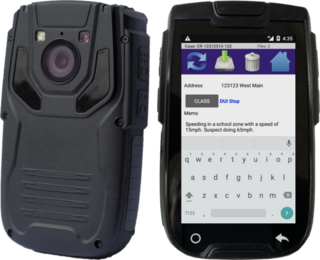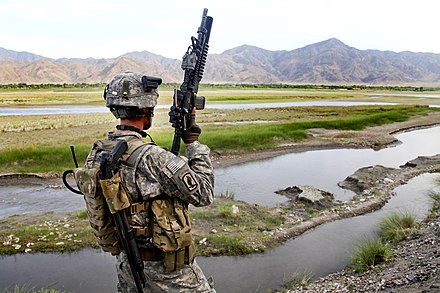
Closed-circuit television (CCTV), also known as video surveillance, is the use of video cameras to transmit a signal to a specific place, on a limited set of monitors. It differs from broadcast television in that the signal is not openly transmitted, though it may employ point-to-point (P2P), point-to-multipoint (P2MP), or mesh wired or wireless links. Though almost all video cameras fit this definition, the term is most often applied to those used for surveillance in areas that may need monitoring such as banks, stores, and other areas where security is needed. Though videotelephony is seldom called "CCTV" one exception is the use of video in distance education, where it is an important tool.

Surveillance is the monitoring of behavior, activities, or information for the purpose of influencing, managing or directing. This can include observation from a distance by means of electronic equipment, such as closed-circuit television (CCTV), or interception of electronically transmitted information, such as Internet traffic. It can also include simple technical methods, such as human intelligence gathering and postal interception.

William Stephen George Mann is a Canadian engineer, professor, and inventor known for his work in augmented reality, computational photography, particularly wearable computing, and high dynamic range imaging. He also founded InteraXon, makers of the Muse and Muse2 brain-sensing headband, and is also a founding member of the IEEE Council on Extended Intelligence (CXI). Mann was born in Canada, and currently lives in Stanford/Palo Alto, California, with his wife and two children.

The Transparent Society (1998) is a non-fiction book by the science-fiction author David Brin in which he forecasts social transparency and some degree of erosion of privacy, as it is overtaken by low-cost surveillance, communication and database technology, and proposes new institutions and practices that he believes would provide benefits that would more than compensate for lost privacy. The work first appeared as a magazine article by Brin in Wired in late 1996. In 2008, security expert Bruce Schneier called the transparent society concept a "myth", claiming it ignores wide differences in the relative power of those who access information.

A hidden camera also known as a spy camera is a still or video camera used to record people without their knowledge. The term “hidden camera” is commonly used in TV shows, sometimes when subjects are unaware that they are being recorded, and usually lacking their knowledge and consent. The term “spy camera” is generally used when the subject would normally be expected to object to being recorded as an invasion of their privacy. The term “security camera” is commonly used to provide a justification for a surreptitious recording, and can be contrasted with security camera, which is visible and which sometimes is accompanied with a warning notice of its presence.

Mass surveillance is the intricate surveillance of an entire or a substantial fraction of a population in order to monitor that group of citizens. The surveillance is often carried out by local and federal governments or governmental organisations, such as organizations like the NSA and the FBI, but it may also be carried out by corporations. Depending on each nation's laws and judicial systems, the legality of and the permission required to engage in mass surveillance varies. It is the single most indicative distinguishing trait of totalitarian regimes. It is also often distinguished from targeted surveillance.

Sousveillance is the recording of an activity by a participant in the activity, typically by way of small wearable or portable personal technologies. The term "sousveillance", coined by Steve Mann, stems from the contrasting French words sur, meaning "above", and sous, meaning "below", i.e. "surveillance" denotes the "eye-in-the-sky" watching from above, whereas "sousveillance" denotes bringing the camera or other means of observation down to human level, either physically, or hierarchically.
A helmet camera, otherwise known as a micro video camera, is an action camera, usually a closed circuit television camera, attached to a helmet allowing someone to make a visual record from their point of view (POV), while keeping their hands and vision free.
Equiveillance is a state of equilibrium, or a desire to attain a state of equilibrium, between surveillance and sousveillance. It is sometimes confused with transparency. This balance (equilibrium) allows the individual to construct their own case from evidence they gather themselves, rather than merely having access to surveillance data that could possibly incriminate them.
Axon Enterprise, Inc. is a Scottsdale, Arizona-based company which develops technology and weapons products for law enforcement and civilians.

An onboard camera or in-car camera is a camera placed upon a moving object, such as a vehicle.
Police accountability involves holding both individual police officers, as well as law enforcement agencies responsible for effectively delivering basic services of crime control and maintaining order, while treating individuals fairly and within the bounds of law. Police are expected to uphold laws, regarding due process, search and seizure, arrests, discrimination, as well as other laws relating to equal employment, sexual harassment, etc. Holding police accountable is important for maintaining the public's "faith in the system". Research has shown that the public prefers independent review of complaints against law enforcement, rather than relying on police departments to conduct internal investigations. There is suggestion that such oversight would improve the public's view on the way in which police officers are held accountable.
Surveillance art is the use of technology intended to record human behavior in a way that offers commentary on the process of surveillance or the technology used to surveil. Surveillance art manifests itself in many different forms, from short films to architecture, but all have been shown to provide some type of critical response to the rise of surveillance by various authorities and the technology used to achieve it, especially when dealing with issues of security and enforcing laws.
Big Brother Watch is a non-profit non-party British civil liberties and privacy campaigning organisation. It was founded in 2009 to campaign against state surveillance and threats to civil liberties.

The Domain Awareness System is a surveillance system developed as part of Lower Manhattan Security Initiative in a partnership between the New York Police Department and Microsoft to monitor New York City. It allows the NYPD to track surveillance targets and gain detailed information about them, and is overseen by the counterterrorism bureau.

Pro-Vision is an American manufacturer of specialty cameras headquartered in Byron Center, Michigan. The company manufactures and sells a variety of cameras including dashcams, body cameras, and backup cameras. The company has appeared on the Inc. 5000 list of the fastest growing American companies from 2011 to 2017. As of December 2016, Pro-Vision products have been used by organizations in over 50 different countries worldwide.

In policing equipment, body worn video (BWV), body-worn camera (BWC), body camera or wearable camera is a wearable audio, video, or photographic recording system used to record events in which law enforcement officers are involved. They are typically worn on the torso of the body on the officer's uniform. Body worn cameras for policing are often similar to other body worn video equipment used by civilians, firefighters, or the military, but are designed to address specific requirements related to law enforcement.
Patrick Harmon was a 50-year-old American man fatally shot from behind by police officer Clinton Fox in Salt Lake City, Utah, on August 13, 2017. The shooting took place after Harmon was pulled over by an officer for riding a bicycle without proper lighting. The incident led to protests in Salt Lake City, some organized by Black Lives Matter.

The New York City Police Department (NYPD) actively monitors public activity in New York City, New York, United States. Historically, surveillance has been used by the NYPD for a range of purposes, including against crime, counter-terrorism, and also for nefarious or controversial subjects such as stealing drugs to resell them, monitoring political demonstrations, activities, and protests, and even entire ethnic and religious groups.

Amazon Neighbors, also known as simply Neighbors, is a neighborhood watch app offered by Amazon and Ring Inc. that allows users to get real-time crime and safety alerts from your neighbors and local law enforcement. The Neighbors Portal is an extension of the Neighbors app that allows police officers to view and comment on public posts as verified law enforcement.

















